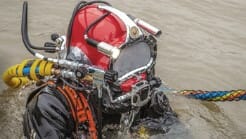

The process of underwater UXO clearance involves much more than simply understanding procedures for ordnance disposal. Before deciding on the most appropriate action in an area contaminated with underwater UXO, a detailed knowledge of local regulations and environment is required.
Local, regional, and international policies, regulations and standards may limit options available for clearance. Underwater environments often contain specific marine life, historical sites, war graves, sensitive infrastructure, or other concerns.
Not all potential UXO and seabed hazards are in areas accessible by mainstream technology. To provide a complete and integrated solution for shallow water and transition zone projects, UXOcontrol has a flexible array of techniques to ensure all situations are covered. These include AUV, WROV and ROD survey and shallow draft inspection/removal vessels, together with in-house diver-based identification and excavation services.
WROV and ROD survey is at the core our company capability. We own and operate a variety of vehicles capable of tasks from simple observation through to complex intervention and UXO deburial and relocation. Using a work class ROV and Remote Operated Dredge, potential Explosive Ordnance items are inspected using an Electromagnetic (EM) coil system or (gradio) magnetometers array in conjunction with high-definition video and acoustic cameras.
At this stage, non-UXO targets can be reclassified as debris or potential archaeological items. Confirmed/suspected EO items are flagged for excavation and final investigation/removal.
UXOcontrol is now wholly owned by the N-Sea Group and continues to support the offshore industry through the delivery of UXO Risk Management. This includes the development of practical strategies for dealing with ERW underwater.
UXOcontrol is 100% owned by the N-Sea Group
Member of: